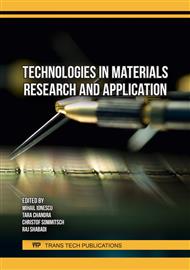[1]
C. Thies, C. Hüls, K. Kieckhäfer, J. Wansart, T. S. Spengler, Project portfolio planning under CO2 fleet emission restrictions in the automotive industry, J. Ind. Ecol. 26.3 (2022) 937-951.
DOI: 10.1111/jiec.13228
Google Scholar
[2]
W. Yu, H. He, N. Cheng, B. Gan, X. Li, Preparation and experiments for a novel kind of foundry core binder made from modified potato starch, Mater. Des. 30.1 (2009) 210-213.
DOI: 10.1016/j.matdes.2008.03.017
Google Scholar
[3]
H. Bargaoui, F. Azzouz, D. Thibault, G. Cailletaud, Thermomechanical behavior of resin bonded foundry sand cores during casting, J. Mater. Process Technol. 246 (2017) 30-41.
DOI: 10.1016/j.jmatprotec.2017.03.002
Google Scholar
[4]
A. Fortini, M. Merlin, & G. Raminella. A comparative analysis on organic and inorganic core binders for a gravity diecasting Al alloy component, Int. J. Met. 16.2 (2022) 674-688.
DOI: 10.1007/s40962-021-00628-1
Google Scholar
[5]
S. Mclntyre. Shell Molding and Shell Core making, ASM Int. Casting, 15 (2008) 598–616.
Google Scholar
[6]
I. Budavári, L. Varga. The Effect of Coremaking Parameters on the Thermal Distortion Behaviour of Resin-Coated Sand, Mater. Sci. Eng. 45.1 (2020) 37-49.
Google Scholar
[7]
R. L. Naro, R. L. Pelfrey. Gas Evolution of Synthetic Core Binders: Relationship to Casting Blowhole Defects.(Retroactive Coverage), Trans. AFS. 91 (1983) 365-376.
Google Scholar
[8]
M.A. Bea, P.S. Kim, K.H. Kim, J.H. Beak, Characterization of the Strength of a Natural Sand and Artificial Sand Core Manufactured with Inorganic Binder, Korean J. Met. Mater, 59.4 (2021) 273-280.
DOI: 10.3365/kjmm.2021.59.4.273
Google Scholar
[9]
K. Yutaka, Properties of Artificial Sand, J. JFS, 89.8, (2017) 464-469
Google Scholar
[10]
R. González, R. Colás, A. Velasco & S. Valtierra, Characteristics of phenolic-urethane cold box sand cores for aluminum casting, Inter. J. Met. 5 (2011) 41-48.
DOI: 10.1007/bf03355506
Google Scholar
[11]
G. Samuels, C. Beckermann, Measurement of gas evolution from PUNB bonded sand as a function of temperature, Inter. J. Met. 6 (2012) 23-40.
DOI: 10.1007/bf03355525
Google Scholar



